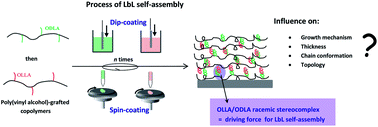Dip- and spin-assisted stereocomplexation-driven LbL self-assembly involving homochiral PVA-g-OLLA and PVA-g-ODLA copolymers†
Abstract
Layer by Layer (LbL) thin films stemming from the formation of stereocomplex between oligolactate of opposite chirality (OLLA and ODLA) covalently anchored onto poly(vinyl alcohol) (PVA) chains is described herein for the first time. The feasibility to construct films by sequential adsorption of PVA-g-ODLA and PVA-g-OLLA graft copolymers is undertaken through the exploitation of two different film deposition techniques, namely dip- and spin-assisted processes. For both deposition methods, infrared spectroscopy in ATR mode reveals a progressive accumulation of matter on the flat substrate during the successive cycle depositions and proves that co-crystallisation involving the two homochiral copolymers is the main driving force for the step by step film build up. Also, the effect of the deposition technique is assessed on the film features in terms of (i) growth mechanism, (ii) internal organization and (iii) surface topology. The strong centrifugal forces associated with fast solvent elimination acting during spinning lead to thinner film with more uniform and homogeneous surface morphology in a much shorter time, than the ones resulting from the dip-assisted process. Such LbL nanometric films, induced by OLLA/ODLA interfacial stereocomplexation, open promising perspectives in the field of biodegradable self-assembled films.


 Please wait while we load your content...
Please wait while we load your content...